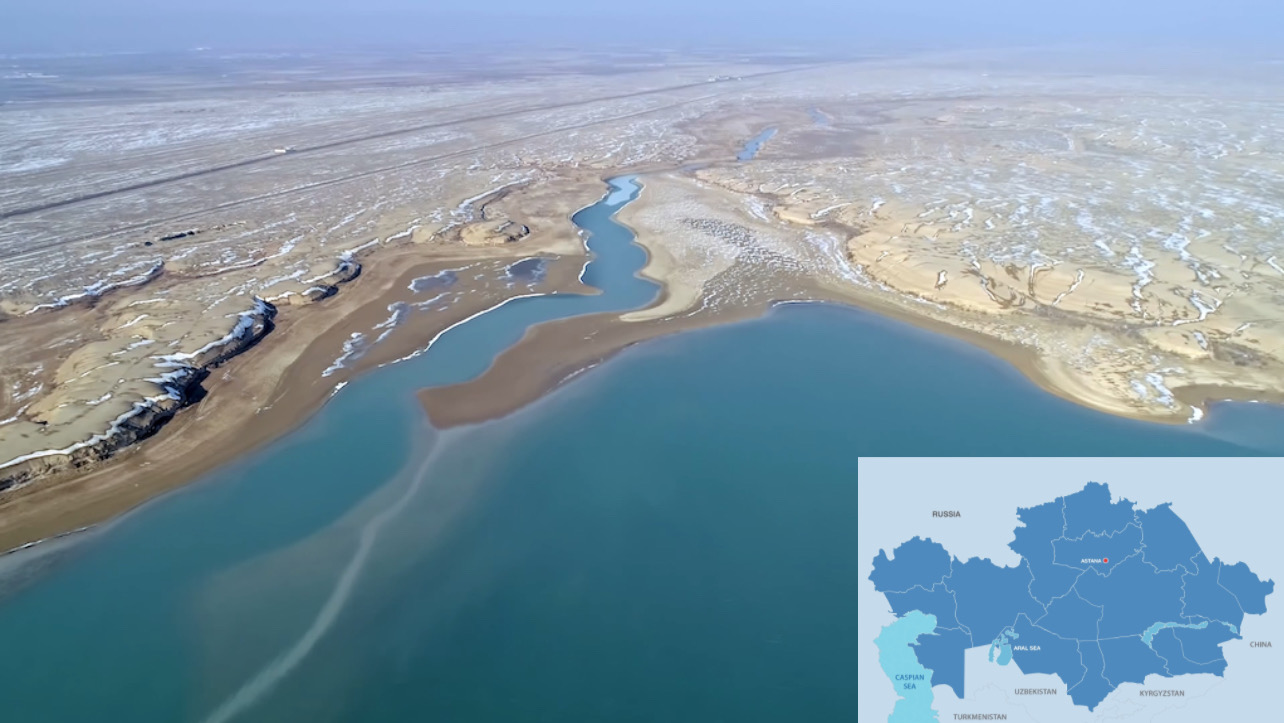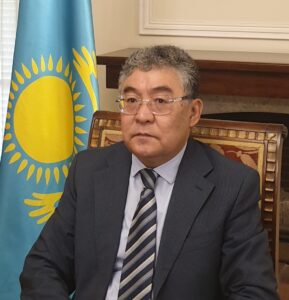In modern realities, with ubiquitous population growth, rapid economic development of states, and increased water consumption per capita, the burden on the environment is steadily growing. Such an intensification of anthropogenic impact provokes and accelerates global climate change processes. In Central Asia, these processes are proceeding faster than the global average. The ecological crisis in the Aral Sea basin is accompanied by progressive scarcity and pollution of water resources, land degradation and desertification of vast territories, and loss of forests, eco-landscapes and biodiversity. On a massive area of the dried–up bottom of the Aral Sea, a new desert has formed – Aralkum, with a size of more than 54,000 square kilometers (for comparison, it is the size of Croatia and much larger than Estonia, Denmark, the Netherlands, and Switzerland).

The Aral Sea, once the largest inland lake in the world, has shrunk tremendously over the past decades. Photo credit: adb.org.
In these challenging conditions, it is highly relevant for the Central Asian States to develop new mechanisms for regional cooperation. The main goal of Kazakhstan’s chairmanship in the International Fund for Saving the Aral Sea (IFAS) is to further increase cooperation on the integrated use and protection of water resources, address environmental issues, socio-economic aspects, and introduce elements of a green economy in Central Asian countries.

Askhat Orazbay
During Kazakhstan’s chairmanship, we will continue to implement two main programs approved by the IFAS Board: the Aral Sea Basin Program-4 (ASBP-4) and its systematic monitoring, as well as the Regional Environmental Protection Program for the Sustainable Development of Central Asia (REPPSD CA). Both programs are slated for implementation until 2030.
The environmental crisis of the Aral Sea, which began to emerge in the 1960s and 1970s, has led to a drastic reduction in the size of what was once the planet’s fourth-largest lake. Initially, the Aral Sea was divided into two, and then three, separate bodies of water, leading to its current state.
During the years of Independence, Kazakhstan, with the support of the World Bank, carried out comprehensive work and restored a small part of the Aral Sea, known as the Small Aral or Northern Aral Sea. However, this restoration represents only about 8% of its original size. The port city of Aralsk, which was once 100 km away from the water’s edge, is now closer due to these restoration efforts.
Particles and dust of salts and toxic chemicals left on the drained bottom of the Aral Sea are found not only in the Tien Shan and Pamir mountains but also far beyond the borders of our region. To reduce these harmful substances, the countries of the Aral Sea region are actively engaged in phytomeliorative measures, such as planting saxaul (Haloxylon) and other vegetation.
However, questions remain about the effectiveness of these plantings on the former seabed. What is the current state of ecosystems? It is known that due to several low-water years in a row, the flow along the Syr Darya has decreased, and the volume of water in the Northern Aral Sea has reduced from a maximum of 27 to 20 cubic kilometers. This reduction has led to a decline in fish catch, adversely affecting local employment. The morbidity rate of the population is on the rise again due to desertification and deterioration of water quality. Will the tragedy happen again? What are the sentiments and plans of the locals? These questions are numerous, and they are all interconnected.
We must thoroughly examine the range of problems and ongoing efforts in the Aral Sea region, update our understanding of these issues, and strive for more prompt and effective solutions.
In the Aral Sea Basin Program-4 (ASBP-4), which I mentioned earlier, the environmental direction is highlighted as a separate main area comprising 12 project proposals.
It’s important to note that joint actions are envisaged to adapt to climate change. These include measures tailored to the most vulnerable sectors such as water and agriculture, drinking water supply, energy, biodiversity, forests, pastures, and mountain ecosystems. A key initiative has been the development of a regional action plan for climate change adaptation. With the support of the GIZ Green Central Asia Program, five Central Asian countries have developed and adopted a Regional Strategy for Climate Change Adaptation.
The program also promotes the dissemination of the best climate-adapted agricultural practices. We will have to develop a regional program for the protection of biological resources in Central Asia, implement measures to preserve and restore ecosystems in the basins of our main rivers – the Amu Darya and the Syrdarya – and continue systematic forest plantations in the Aral Sea region (Priaralye) zone and on the drained bottom of the Aral Sea.
The environmental projects underway aim to develop a system for monitoring the state of the environment and water resources in the Aral Sea region (Priaralye) and on the drained seabed. Additionally, they focus on developing environmental innovations and technologies specifically for the Priaralye zone.
A notable project is the improvement of water quality in rivers and reservoirs, aligning with international standards, and addressing pollution, including industrial waste. Kazakhstan, among other countries, is working towards joining the Protocol on Water and Health under the Convention on the Protection and Use of Transboundary Watercourses and International Lakes. Uzbekistan has recently become a party to this protocol.
These initiatives also include reducing the risks of natural disasters such as floods, mudflows, and droughts in the Aral Sea basin. They involve studying the state of glaciers in the upper reaches of transboundary rivers, developing transboundary eco-corridors, and establishing regional networks of specially protected natural areas for biodiversity conservation. These are just a few of the many projects that we aim to promote during our chairmanship of IFAS.
Let’s also discuss new initiatives that will be carried out within the framework of Kazakhstan’s chairmanship in the IFAS. These include creating a long-term and sustainable regional cooperation mechanism for the effective use of water and energy resources in Central Asia, taking into consideration the interests of all countries in the region in the fields of irrigation, hydropower, and ecology.
Systematic work is also needed to implement a unified automated system for accounting, monitoring, management, and distribution of water resources in the Aral Sea basin. President Kassym-Jomart Tokayev, at a meeting of the Council of Heads of States-Founders of the IFAS in Dushanbe on Sept. 15, 2023, called on the parties to begin implementing these initiatives.
Strengthening regional cooperation with international development partners, UN structural entities, financial institutions, and the donor community plays a crucial role. It is important to intensify activities within the framework of widely recognized international environmental conventions, action plans, declarations, and joint statements.
From 2024 to 2026, Kazakhstan is committed to implementing the directives and agreements reached by the Heads of States at the IFAS Summit last year. This commitment extends to previously concluded agreements, which will ensure the consistency of Central Asia’s actions to achieve the global Sustainable Development Goals and its positioning as a unified region.
The author is the Chairperson of the Executive Committee of the International Fund for Saving the Aral Sea (IFAS).

